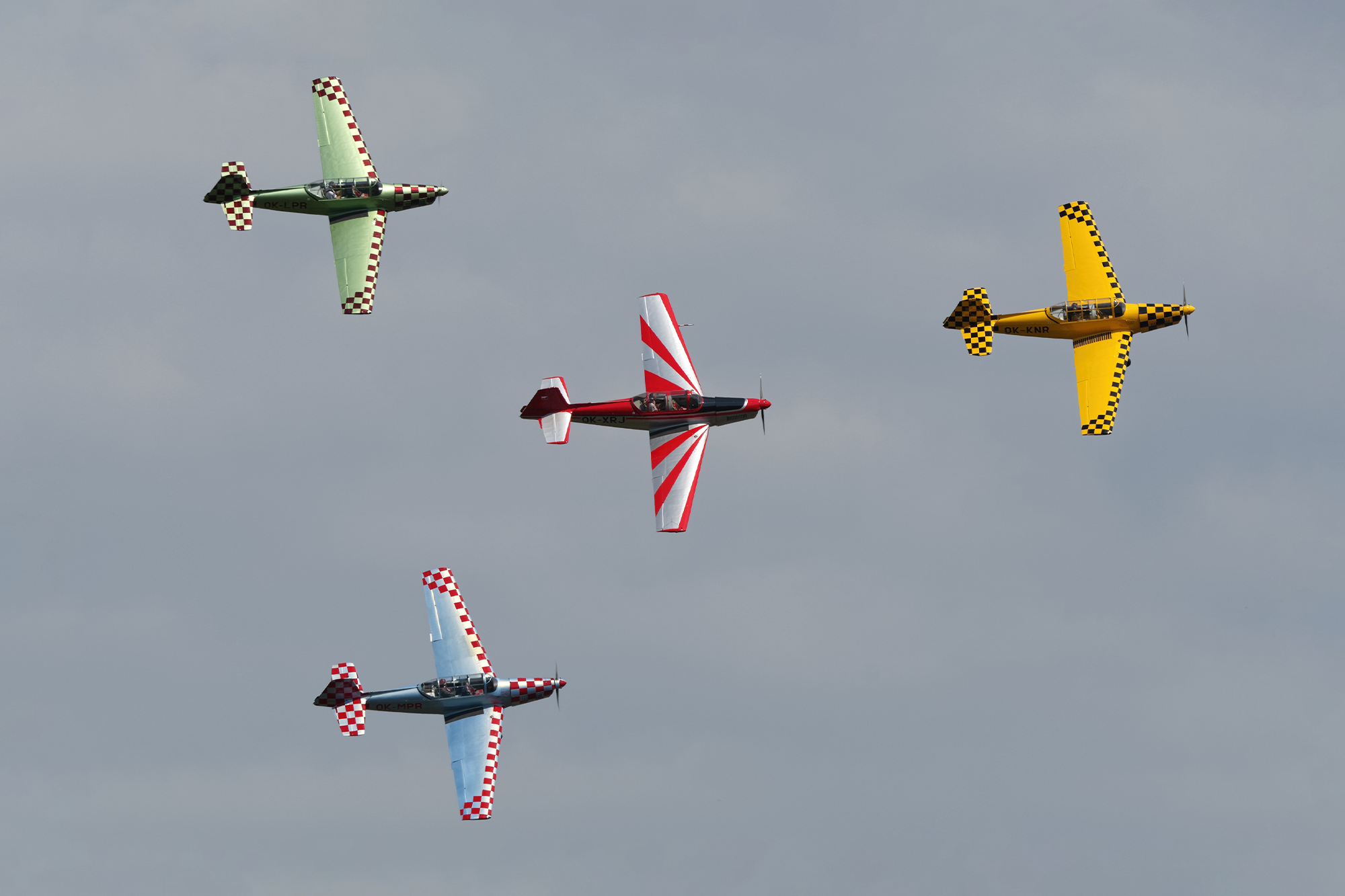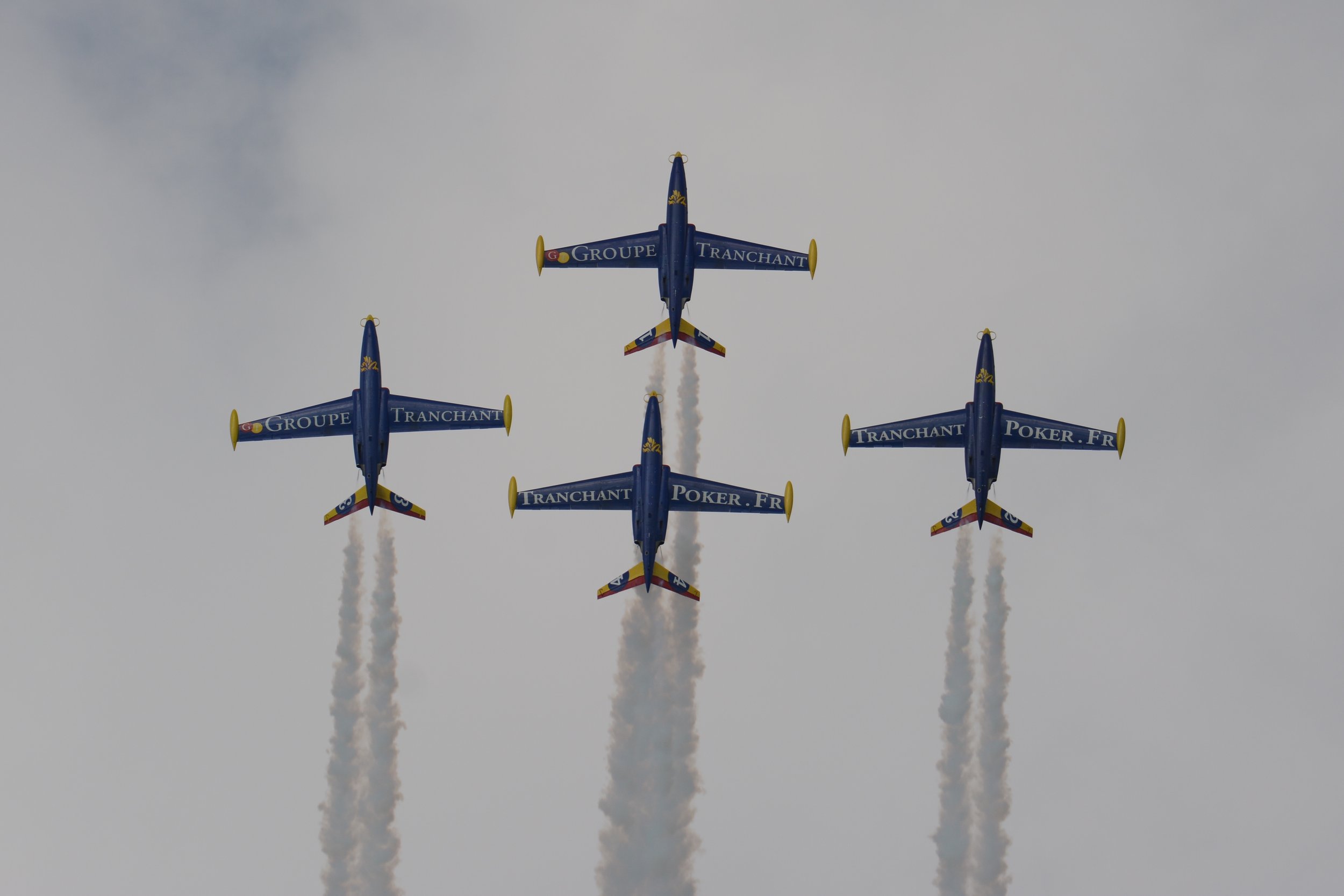Retro Sky Team
Country
Slovakia
Size
7 Aircraft
Base
Kosice International Airport
Retro Sky Team is a Slovakian group known for recreating WWII air battles. Back in 2009, a dedicated bunch at the Aeroclub of Kosice took the bold step of adorning their Zlín 226 planes in striking military camouflage. These specially painted aircraft, reminiscent of the German Luftwaffe's Messerschmitt Bf 109s, captivated onlookers with their unique tribute. Alongside the Luftwaffe-inspired Zlín 226s stand the Zlín 526, donning the iconic colours of the Soviet MIG 3. This squadron of six planes, which also includes the YAK 52 and Zlin 326, plays a pivotal role in the airshows, showcasing thrilling aerial skirmishes complete with smoke effects and ground pyrotechnics. Adding to the spectacle is the team's possession of an Antonov An-2, faithfully painted in Soviet Air Forces livery, often joining the primary six aircraft during performances. In the past, the Polikarpov Po-2 was a familiar sight in their displays too. The Retro Sky Team is a fixture at airshows, social gatherings, and WWII historical reenactments across Europe, with all its skilled pilots proudly hailing from the Aeroclub Kosice.
| Back to Top |
Zlin Z-226
The Zlin Z 226 is a single-engine two-seat trainer aircraft produced by the Czechoslovak manufacturer Moravan Otrokovice (today ZLIN Aircraft Otrokovice, Czech Republic). The Z 226 is capable of aerobatics and is often used to tow sailplanes. It is a member of the Zlin Trener family (Z 26, Z 126, Z 226, Z 326, Z 526, Z 726). The Zlin Trener is a family of aircraft that was based on a basic training aircraft, the Z-26. The original Z-26 was designed in the 1940s and produced in 1946 by the Czechoslovakian company, Moravan to meet a requirement for a basic trainer to replace the Bücker Jungmann and Bestmann. It was a low-wing monoplane of mixed construction, with wooden wings and a welded metal tube fuselage, powered by a single four-cylinder piston engine, the Walter Minor 4-III. It first flew in early 1947, proving superior to the competing Praga 112, and was declared the winner, entering production in 1948. Later Z-26 variants were optimised to participate in aerobatic competitions and many were owned by private pilot owners. Both the two-seat Trener and the single-seat Akrobat were considered highly successful, winning several aerobatic awards in the 1960s
| Back to Top |
Zlin Z-326 Trener Master
The Zlin Z 326 Trener Master is a single-engine two-seat trainer aircraft with retractable landing gear produced by the Czechoslovak manufacturer Moravan Otrokovice (today ZLIN Aircraft Otrokovice, Czech Republic). The Z 326 is capable of aerobatics and is often used to tow sailplanes. It is a member of the Zlin Trener family (Z 26, Z 126, Z 226, Z 326, Z 526, Z 726).
| Back to Top |
Zlin Z-526A
The Zlin Z-526 Akrobat is a Czech sports plane used in aerobatics. The Z-526 was originally designed by Zlin Aircraft in 1959. Its two-seat version is called the Trener-Master. The Z 526's layout was organized with the pilot in the rear, and the student in front. The aircraft could be equipped also with tip tanks and a constant speed propeller. The Z-526F was introduced in 1968 and was equipped with a 135 kW (180 hp) Avia M 137A engine, the export version Z-526L differing by being equipped with a 150 kW (200 hp) Lycoming AEIO-360 flat-four. Single-seat versions included the Z-526A, Z-526AS, and the Z-526AFS. The Z-526 AFM was built between 1981 and 1984 and was powered by a 155 kW (210 hp) Avia M337 engine, had tip tanks and a lengthened fuselage. The aircraft was later developed into the Zlin Z-726. More than 1,400 Z-526s were manufactured, many for military and private flying schools.
| Back to Top |
Yakovlev Yak-52
The Yakovlev Yak-52 is a Soviet primary trainer aircraft which first flew in 1976. It was produced in Romania from 1977 to 1998 by Aerostar, as Iak-52, which gained manufacturing rights under agreement within the former COMECON socialist trade organisation. The Yak-52 was designed as an aerobatic trainer for students in the Soviet DOSAAF training organisation, which trained civilian sport pilots and military pilots. Currently the Yak-52 is used in the Fédération Aéronautique Internationale (FAI) World Aerobatic Yak 52 Competition, a popular powered aircraft one-design World Aerobatic Championship.
A descendant of the single-seat competition aerobatic Yakovlev Yak-50, the all-metal Yak-52 is powered by a 268 kW (360 hp) Vedeneyev M14P nine-cylinder radial engine.
Since the aircraft was designed to serve as a military trainer, the development of the aircraft incorporates a number of features to be found on the early postwar fighters: notably the cockpit tandem layout (instrument panel, seat design, cockpit opening system), tail design, tricycle landing gear, fuselage mixed construction (monocoque with steel tube construction), inner flaps, controls position, access panels on sides of the fuselage, even the location of the radio antenna and overall dimensions of the airplane, which extensively match the Yakovlev Yak-17 UTI jet fighter trainer (NATO code name Magnet).
The aircraft has fuel and oil systems permitting inverted flight for as long as two minutes. The engine drives a two-bladed counter-clockwise rotating, variable pitch, wood and fiberglass laminate propeller.
At 998 kg (2,200 lb) empty weight, the Yak-52 is responsive and very capable as an aerobatic aircraft. Yet it is also easy to fly and land. It has been used in international aerobatic competition up to the Advanced level. It is stressed to +7 and –5 Gs, rolls (to the right) at well more than 180 degrees/second (measured up to 352 degrees/second to the right), and is capable of every manoeuvre in the Aresti catalog.
The Yak-52, like most Soviet military aircraft, was designed to operate in rugged environments with minimal maintenance. One of its key features, unusual in western aircraft, is its extensive pneumatic system. Engine starting, landing gear, flaps, and wheel brakes are all pneumatically actuated. Spherical storage bottles for air, replenished by an engine driven compressor, are situated behind the rear cockpit and contents displayed on the instrument panels. The operating pressure is between 10 and 50 bars (145 and 725 psi) and an emergency circuit is reserved for lowering the undercarriage if the normal supply is exhausted or the compressor fails. Additionally both main and reserve bottles can be charged from a port on the ground with compressed air, usually from a scuba type air bottle. The ground steering/braking arrangement, especially, takes some adjustment for flyers accustomed to hydraulics, because the aircraft uses differential braking controlled by rudder pedals and a hand-operated lever on the control stick.
The tricycle landing gear is retractable, but it remains partially exposed in the retracted position, affording both a useful level of drag in down manoeuvres and a measure of protection should the aircraft be forced to land "wheels up."
A number of "westernised" versions of the Yak-52 are now produced. The replacement of the existing Soviet avionics, fitting of a three-blade propeller and the M14PF 298 kW (400 hp) upgrade to the usual 360 hp M14P engine, and conversion to conventional "tail-dragger" landing gear (Yak-52TD) are some of the modifications made to the standard aircraft. There is also a factory-produced Yak-52TW tail-dragger version. The TW has an extra 120 l (32 US gal) of fuel capacity in two extra wing tanks, the M14PF engine designated & three blade propeller, an electric start, and modern instruments.
On April 16, 2004, a modernised variant Yak-52M was flown in Russia. It is fitted with modernised M-14Kh engine, three-blade propeller, and other modifications.
| Back to Top |
Antonov An-2
The Antonov An-2 NATO reporting name Colt is a Soviet mass-produced single-engine biplane utility/agricultural aircraft designed and manufactured by the Antonov Design Bureau beginning in 1946. Its remarkable durability, high lifting power, and ability to take off and land from poor runways have given it a long service life. The An-2 was produced up to 2001 and remains in service with military and civilian operators around the world.
The An-2 was designed as a utility aircraft for use in forestry and agriculture. However, the basic airframe is highly adaptable and numerous variants of the type have been developed; these include hopper-equipped versions for crop-dusting, scientific versions for atmospheric sampling, water-bombers for fighting forest-fires, flying ambulances, float-equipped seaplane versions and lightly armed combat versions for dropping paratroops. The most common version is the An-2T 12-seater passenger aircraft. All versions (other than the An-3 and the An-2-100) are powered by a 750 kW (1,010 hp) nine-cylinder Shvetsov ASh-62 radial engine, which was developed from the Wright R-1820. The An-2 typically consumes 2.5 l/min (0.66 US gal/min; 0.55 imp gal/min)
| Back to Top |






| Back to Top |

































